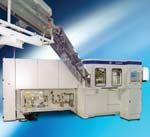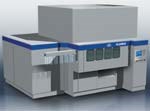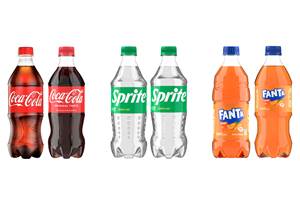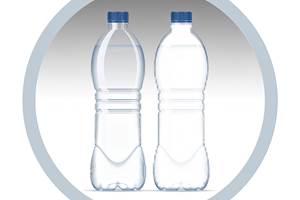Barrier Coating, Hot Filling And More PET Bottle Machinery News
PET blow molding machinery supplier SIG Corpoplast in Hamburg, Germany, used its annual International Technology Conference in October to announce a new barrier-coating system and several other new developments in PET preform machines and reheat stretch-blow units.
PET blow molding machinery supplier SIG Corpoplast in Hamburg, Germany, used its annual International Technology Conference in October to announce a new barrier-coating system and several other new developments in PET preform machines and reheat stretch-blow units. The firm also unveiled a new integrated blow-and-fill line and plans for aseptic blow molding machinery.
Corpoplast is part of SIG Beverages, a new 11-month-old division of the Swiss-based SIG Group. The Group comprises the former Krupp blow molding companies as well as SIG Simonazzi, a group of German and Italian companies that supply filling, capping, labeling, and can-making machinery and complete turnkey systems for beverages and foods.
New barrier coating
A pulsed, cold-plasma process that deposits a thin-layer of glass-like silicon oxide on the interior of a PET bottle represents SIG's entry into barrier-coating technology. (Two European competitors—Sidel S.A. of France and Krones of Germany—also supply barrier-coating systems for PET bottles.)
SIG Corpoplast is developing the new Plasmax PET bottle-coating system in cooperation with Schott HiCotec of Mainz, Germany, which develops and supplies cold-plasma coating technology for glass and plastic pharmaceutical bottles. Schott HiCotec's Plasma Impulse Chemical Vapor Deposition (PICVD) is being adapted for use on PET bottles. The process creates a barrier to oxygen, carbon dioxide, moisture, and chemicals.
The PICVD process has been used on mirrors, polycarbonate optical lenses, and pharmaceutical vials. SIG is aiming at PET bottles for beer, other oxygen-sensitive drinks, and small carbonated soft-drink bottles.
The PICVD process deposits first a transparent adhesive layer and then a colorless silicon oxide (SiOx) barrier layer 0.01 to 0.1 microns thick. The SiOx layer reportedly improves oxygen barrier of the bottle more than 10 times, and the CO2 barrier more than seven times, says Klaus Hartwig, head of technology at SIG Corpoplast. He points out that these barrier improvements remain after hot filling or pasteurization. He also says this approach costs less than other barrier technologies. SIG expects the costs of Plasmax to be about $12 to $15/1000 bottles, which adds less than 20% to the production costs of an uncoated PET bottle. The barrier cost may be partly offset by allowing molders to make thinner bottles.
SIG and Schott HiCotec anticipate that the SiOx coating will receive FDA approval for use with PET bottles, since it is already approved for other products. SIG also expects the SiOx-coated bottles to be recyclable by normal means with no additional steps required in most cases.
The Plasmax coating unit is designed to run in-line with a high-output Blowmax stretch-blow machine. SIG and Schott HiCotec are developing a 12-station rotary coating system for bottles from 100 cc to 1 liter. This Plasmax 12D model will be a two-cavity machine capable of coating 0.5-liter bottles at rates up to 10,000/hr. It will be available for testing early next year and available commercially next September.
The process occurs in a vacuum chamber, where the bottles are held neck down. A lance inserted into the evacuated bottle fills it with gaseous hexamethyl disiloxane. Microwaves are then generated to decompose the gaseous precursor, resulting in a deposit of SiOx on the bottle. Byproducts—CO2 and water—are removed by the vacuum system. This is described as a pulsed plasma system, in which changing certain process variables alters the plasma gas from one with adhesive qualities to one with barrier qualities. "The adhesive layer is made to display characteristics somewhere between those of PET and glass," says Dr. Stephan Behle, project manager for barrier coatings and vice director of R&D at Schott HiCotec.
Modular machines
Fresh details were presented on the Blomax Series III reheat stretch-blow machines, which were first announced at the K 2001 show in Dusseldorf and introduced for sale early this year. These machines have a special linear heating oven that speeds product changeovers, in addition to having modular, "plug-and-play" blowing stations that can be added or removed as needed.
At the conference, SIG elaborated on the machines' improved preform heating, which is due to higher-powered lamps and reduced mandrel pitch of 38 mm for longer heat exposure. A mandrel pitch of 50 mm is offered for heating preforms with wider necks (36 to 49 mm). Other improvements include new cam-operated stretch rods that improve bottle wall distribution. Other features permit 9% faster crystallization and relaxation, 7% more efficient cooling with "rinsing" air, and 50% faster mold opening with a new cam design.
SIG Corpoplast unveiled Blomax 16E, a 16-cavity unit that is the first Series III model designed for hot-fillable bottles. It has a new mold design with improved heating. The mold outer shell is heated to 320 F and the base mold to 176 F. The blow pin delivers cool air after blowing the bottle, which results in faster cooling. Three orders are already on the books from a U.S. molder.
SIG Corpoplast recently added smaller Blomax III models with four, six, and eight cavities to the larger models that have up to 20 mold stations. In 2003, the firm expects to roll out 24- and 28-station models, and later a 20-station unit with dual cavities. Estimated outputs will be 36,000, 42,000, and 52,500 bottles/hr, respectively.
SIG Corpoplast's Brazilian plant has developed the smallest units in the Blomax line. The new Blomax XT series comes with one, two, or three cavities. A Blomax 3T can produce 2L bottles in three cavities at rates up to 1200 bottles/hr/cavity, while the 2T can make 5L bottles in two cavities at 900-1000 bottles/hr/cavity. The largest bottle, 8 liters, can be molded on the Blomax 1T in a single cavity at up to 850/hr. These lower-output machines have a new clamping unit and servo-driven preform positioning. They supersede Series II models, which had pneumatic preform positioning and handled bottle sizes up to 2.5L. The new units will be offered at the same prices as the Series II.
Compact preform molds
SIG Corpoplast also announced developments in its Premax PET preform injection molding systems. The new Premax Compact Series features a reduced vertical mold pitch from 70 mm to 55 mm. This allows the hot-runner molds to carry more cavities in a smaller space. Now a Compact 96-cavity mold fits in the same press that was previously used with a 72-cavity mold, while a Compact 64-cavity system fits in a press for a 48-cavity mold. The new Compact Series also features increased clamp and ejection speeds. The two-stage injection system comes with a new check ring, a take-out robot, and a four-station air- and water-cooling system.
Blow/fill/seal for water
SIG Simonazzi, a Parma, Italy, division of SIG beverages that offers complete bottle filling and handling systems, offers a new stretch-blow molding, filling, and capping system. The new Sinergia system is a collaboration with SIG Corpoplast and integrates the new Blomax series III machine with Simonazzi's Stilljet filler. Non-carbonated beverages can be packaged at rates from 12,000 to 36,000 bottles/hr. The line handles bottles from 0.5 to 2L and comes in a wide variety of standard arrangements of blowing cavities, filling valves, and capping heads.
Simonazzi is also developing a new aseptic blow molding system to be called Ecoshield EPT. It will carry out filling and capping operations under pressure. The machine will be available next year.
Related Content
50 Years...600 Issues...and Still Counting
Matt Naitove marks his first half-century in plastics reporting, with a few of his favorite headlines.
Read MoreCoca-Cola’s Redesign of Small PET Bottles Pushes Lightweighting Below Prior ‘Floor’
Coca-Cola thought it had reached the limits of lightweighting for its small PET carbonated soft drink bottles. But a “complete redesign” led to a further 12% reduction.
Read MoreAdding Remote Service Functions for PET Bottle Blowing
KHS has added features to its internet machine communications portal for PET stretch-blow molding.
Read MoreMold Opaque White PET Bottles – Without Pigment
Trexel and Husky are cooperating on molding recyclable opaque white preforms for PET bottles, which provide a light barrier using foam instead of pigment.
Read MoreRead Next
Lead the Conversation, Change the Conversation
Coverage of single-use plastics can be both misleading and demoralizing. Here are 10 tips for changing the perception of the plastics industry at your company and in your community.
Read MoreAdvanced Recycling: Beyond Pyrolysis
Consumer-product brand owners increasingly see advanced chemical recycling as a necessary complement to mechanical recycling if they are to meet ambitious goals for a circular economy in the next decade. Dozens of technology providers are developing new technologies to overcome the limitations of existing pyrolysis methods and to commercialize various alternative approaches to chemical recycling of plastics.
Read MoreProcessor Turns to AI to Help Keep Machines Humming
At captive processor McConkey, a new generation of artificial intelligence models, highlighted by ChatGPT, is helping it wade through the shortage of skilled labor and keep its production lines churning out good parts.
Read More































